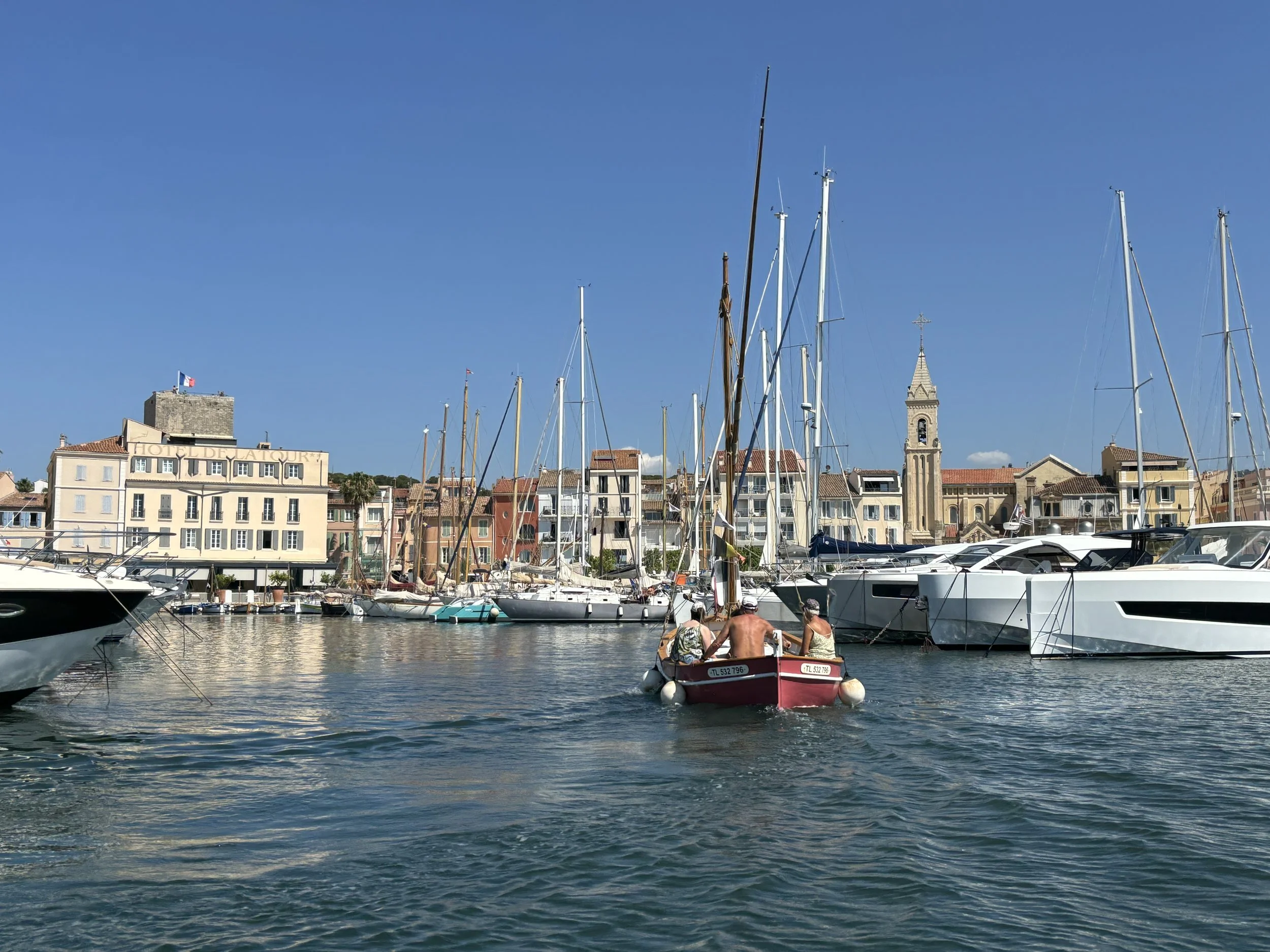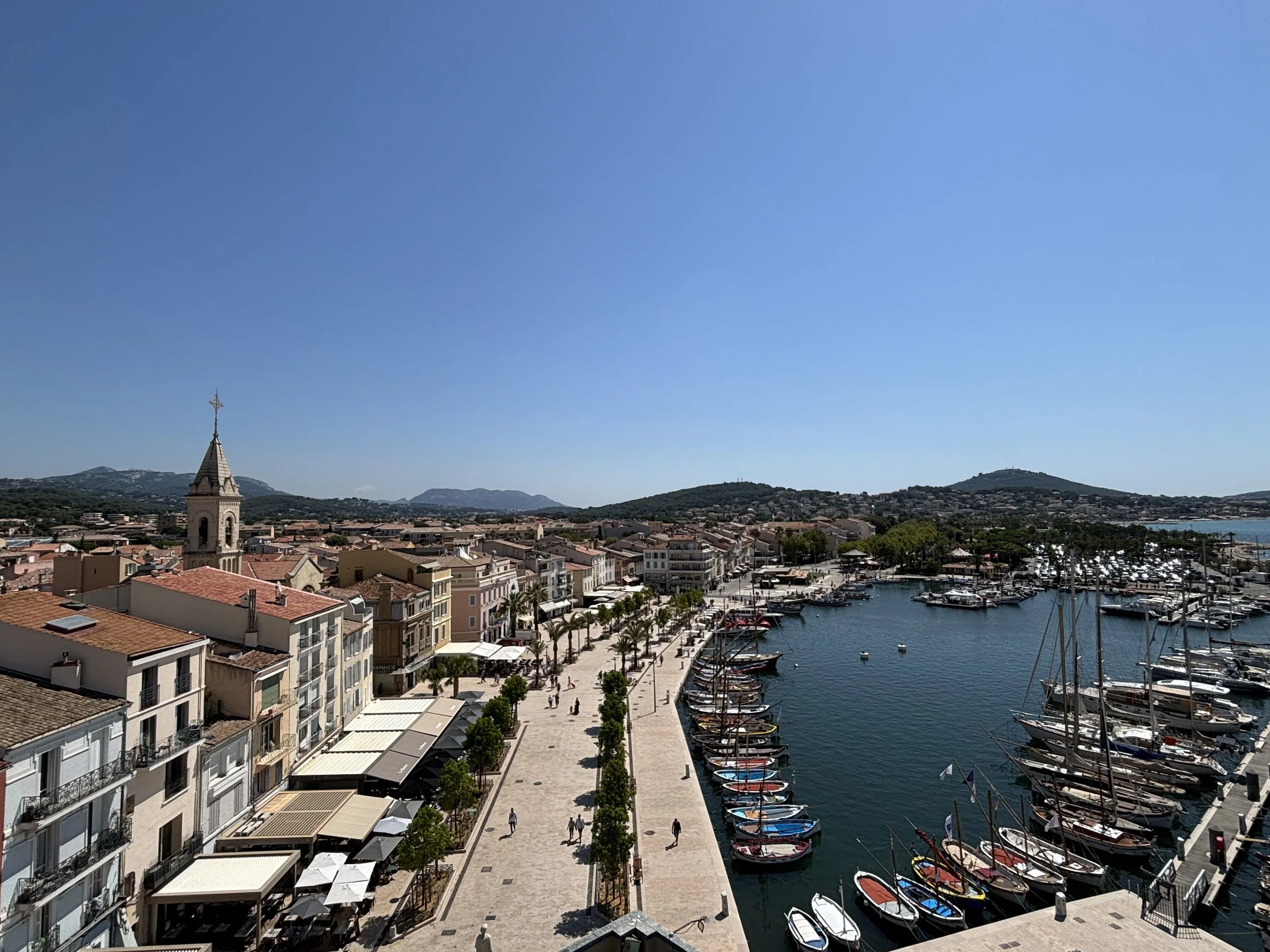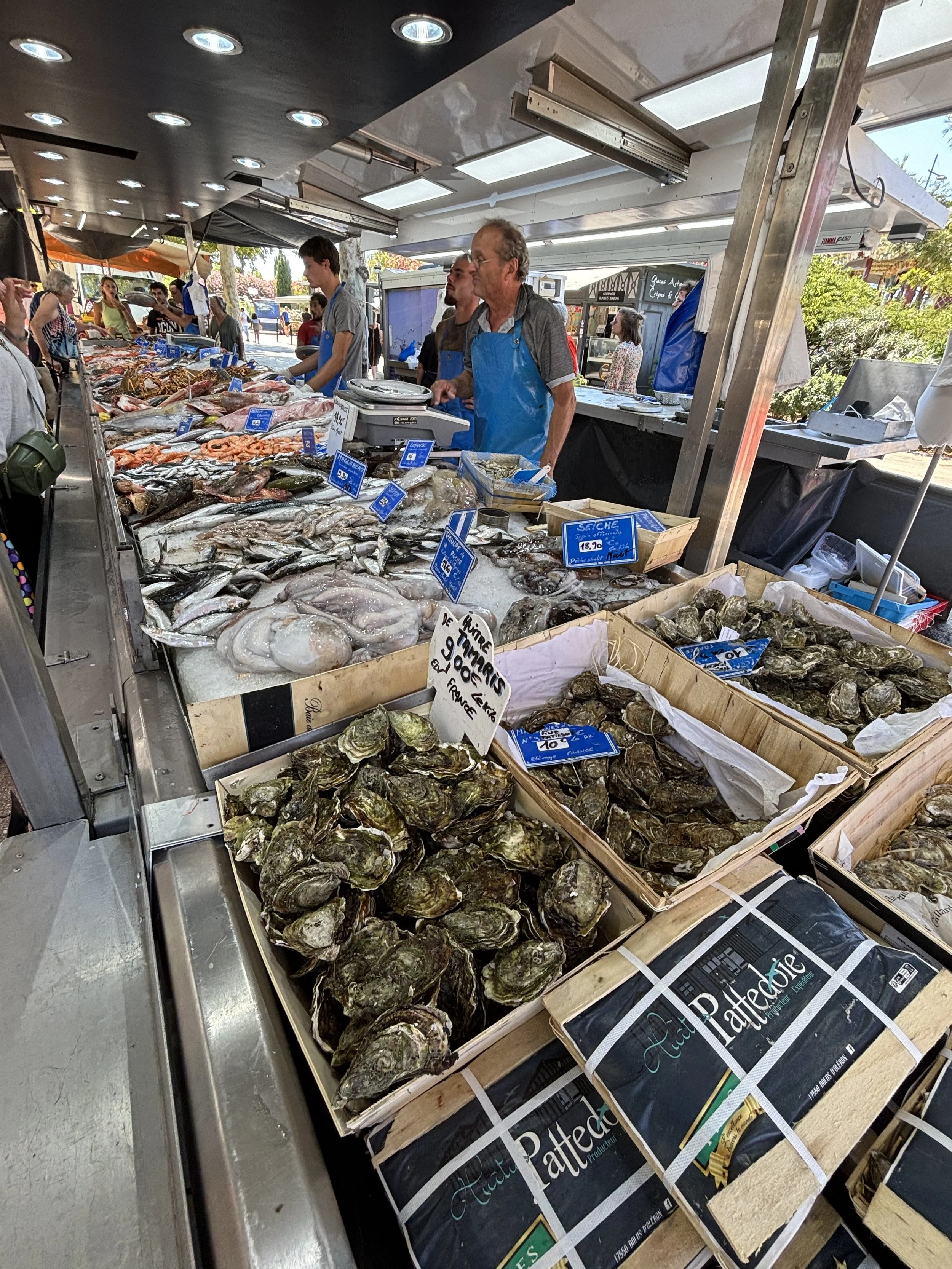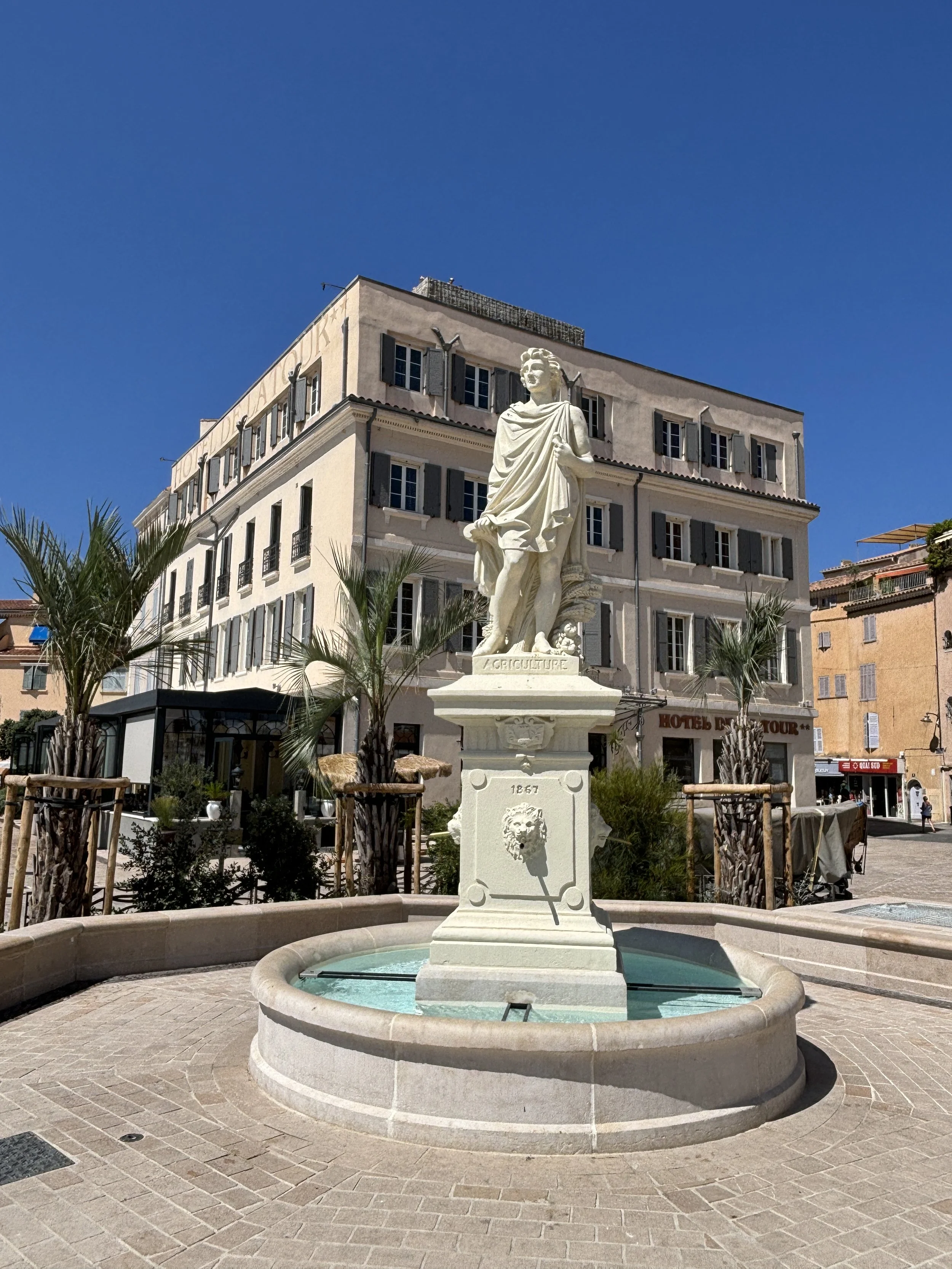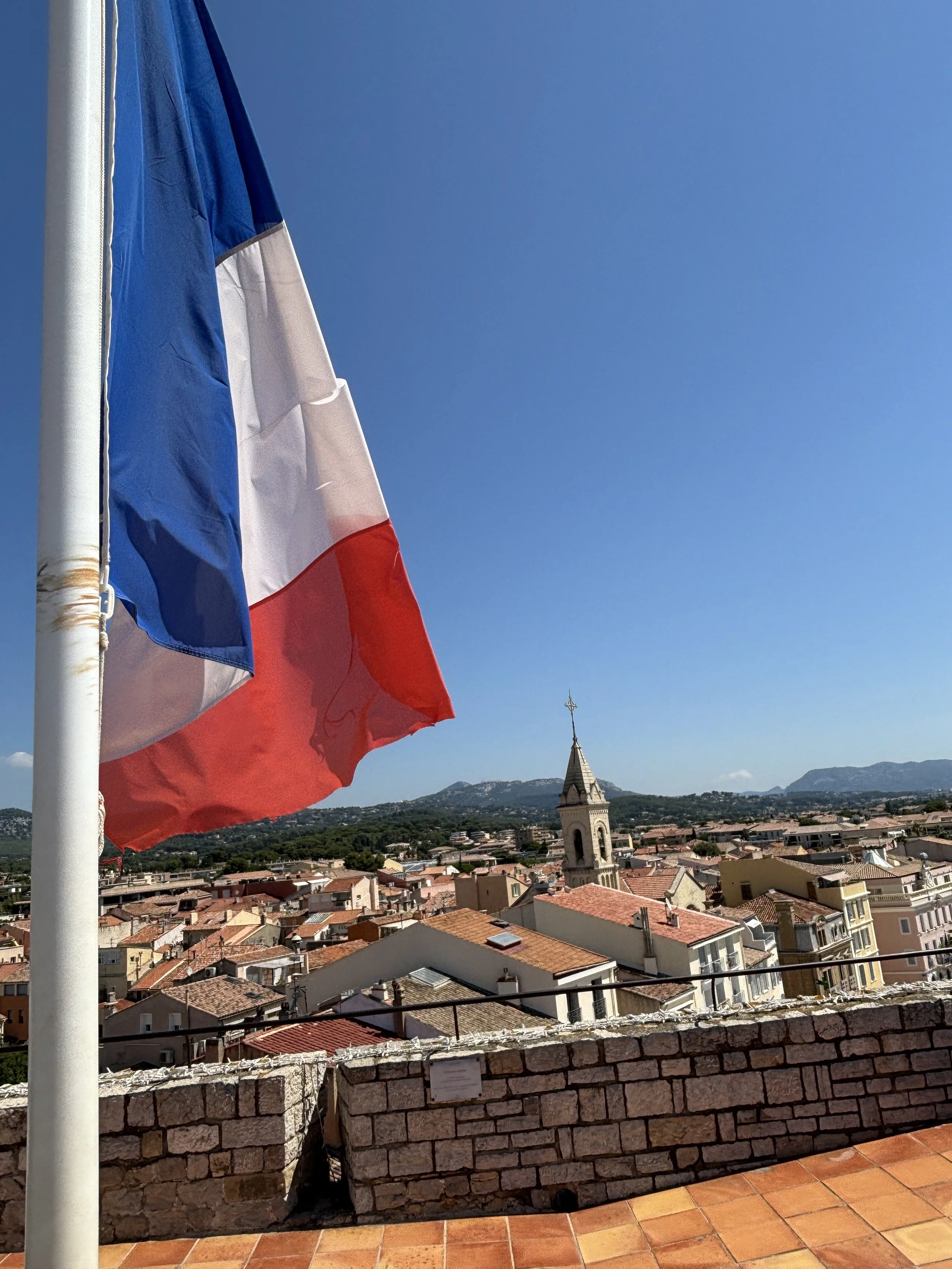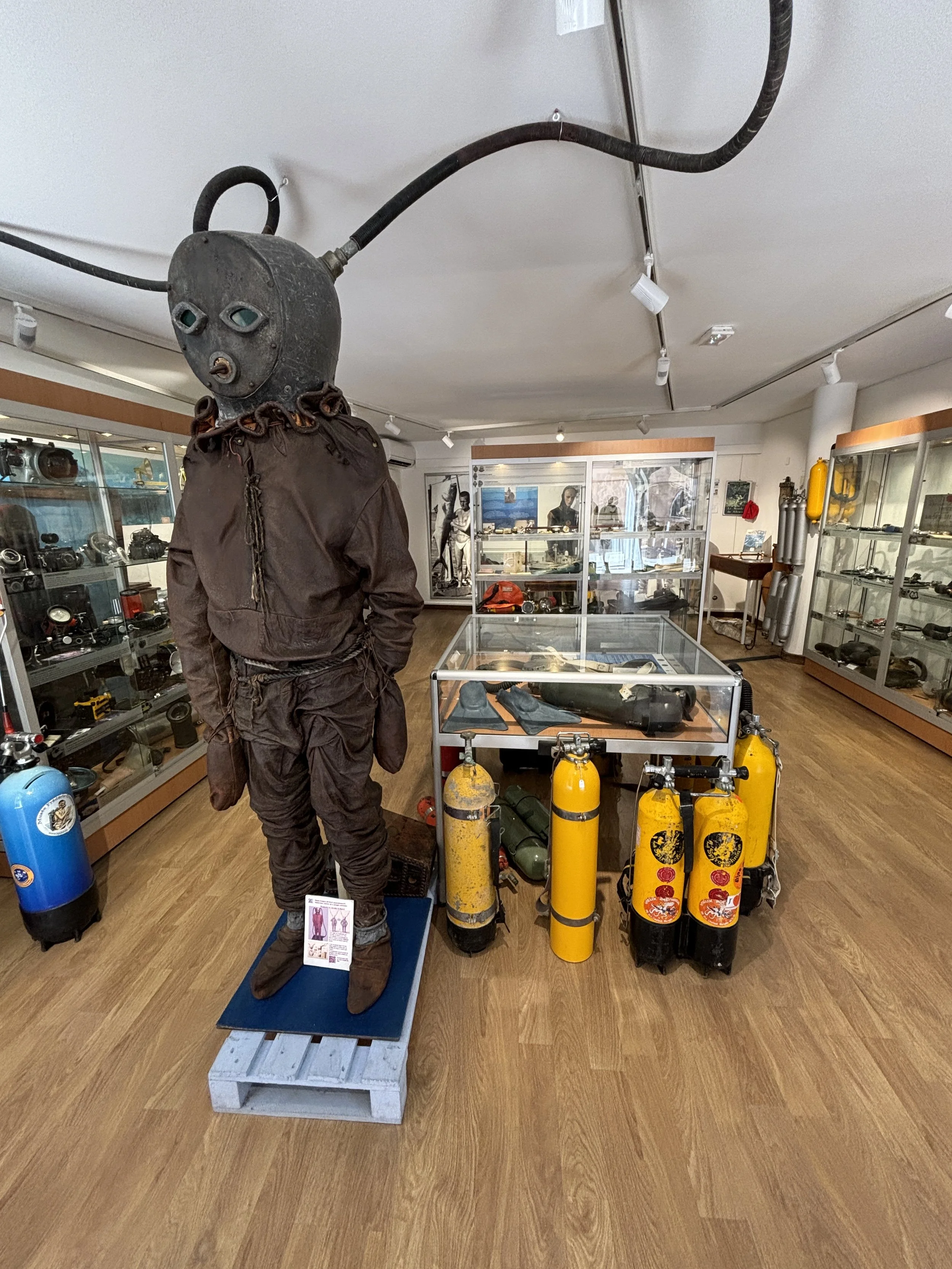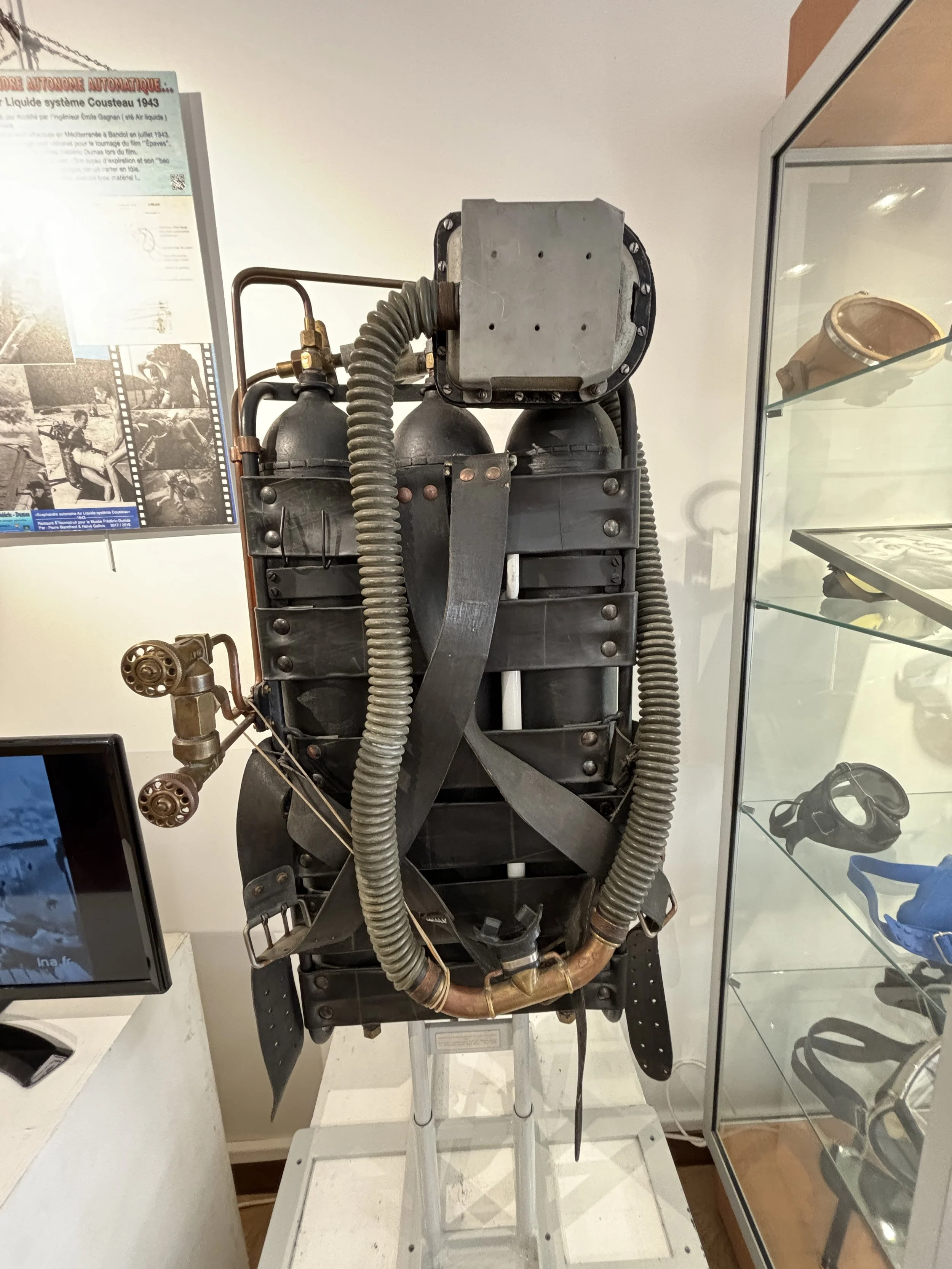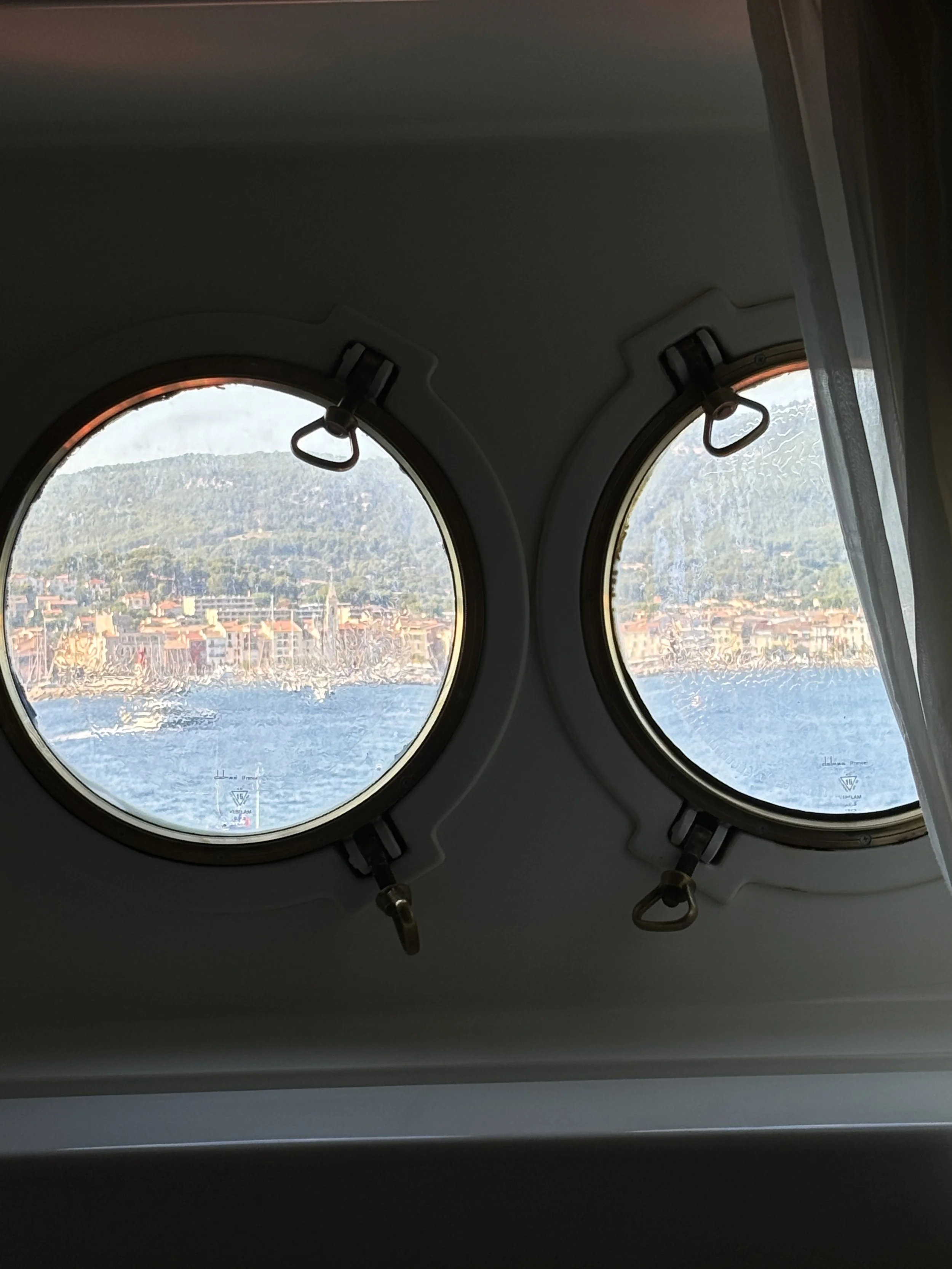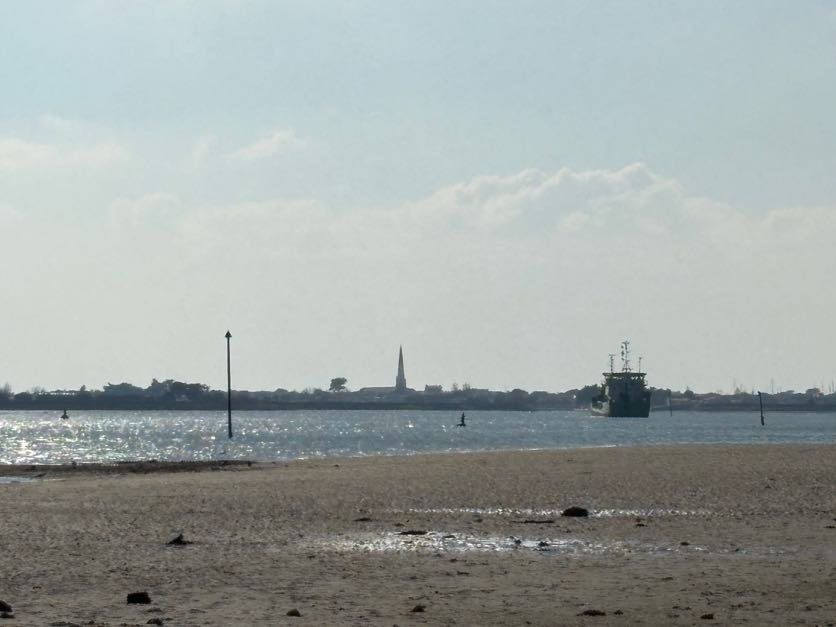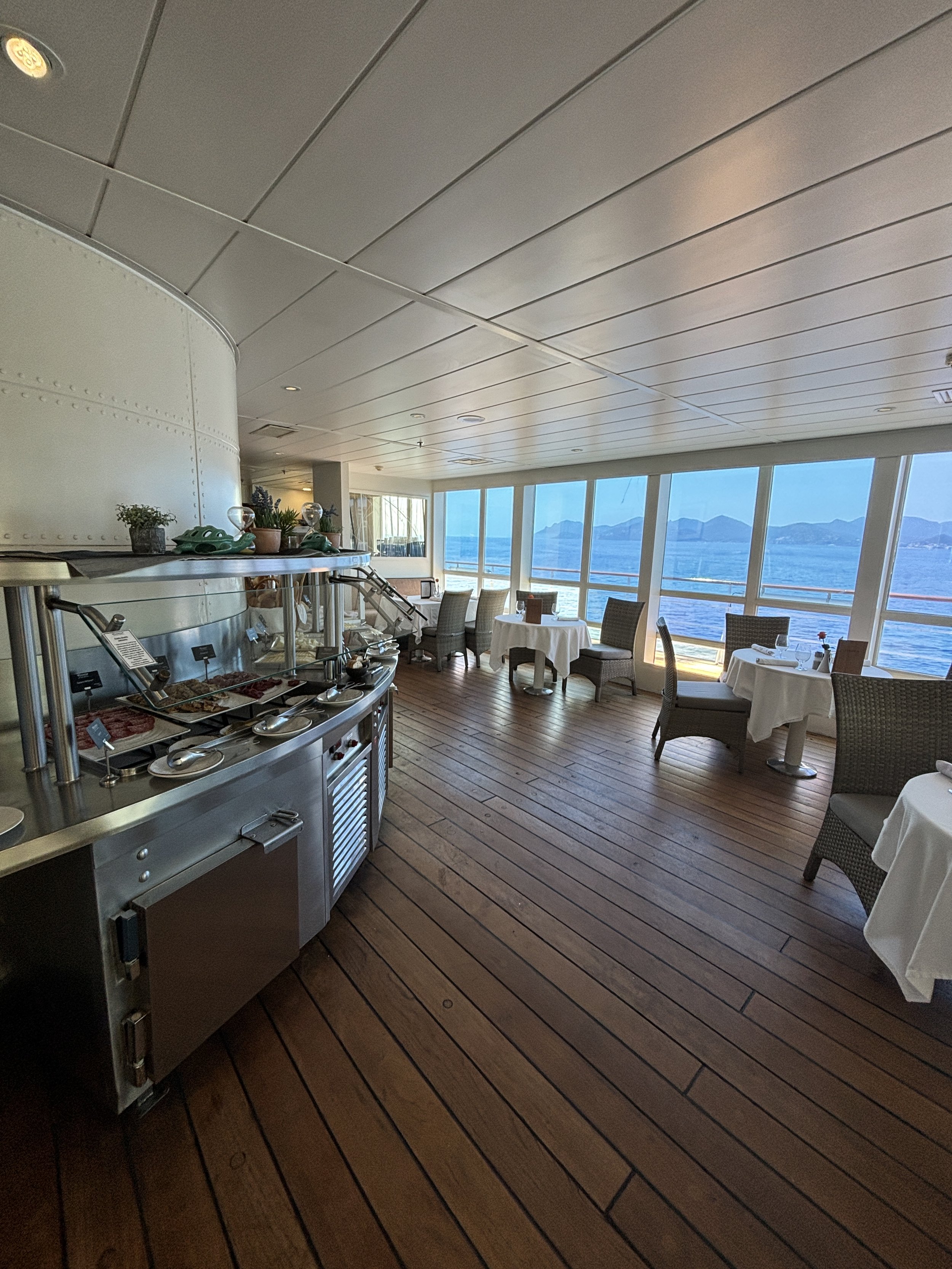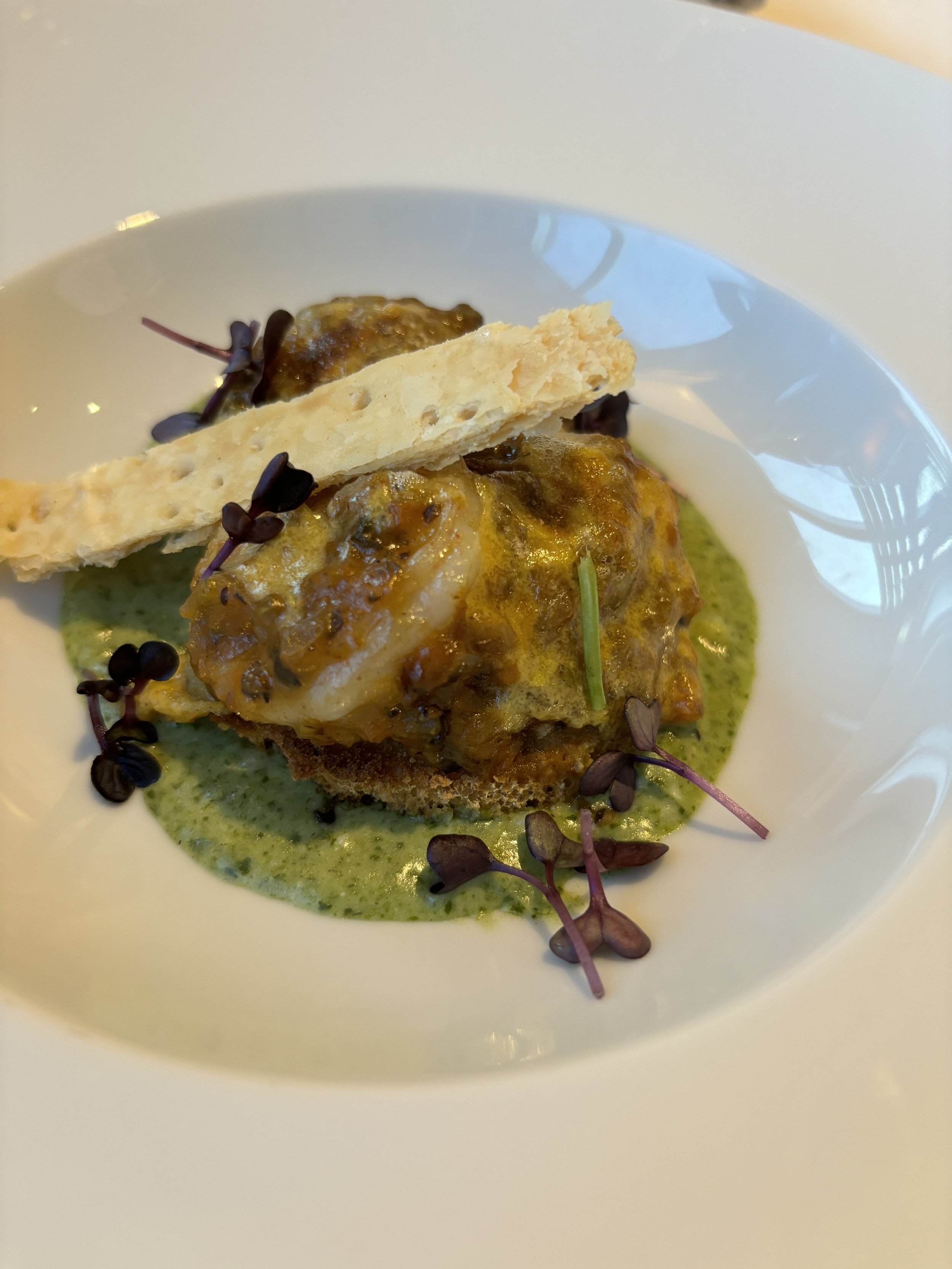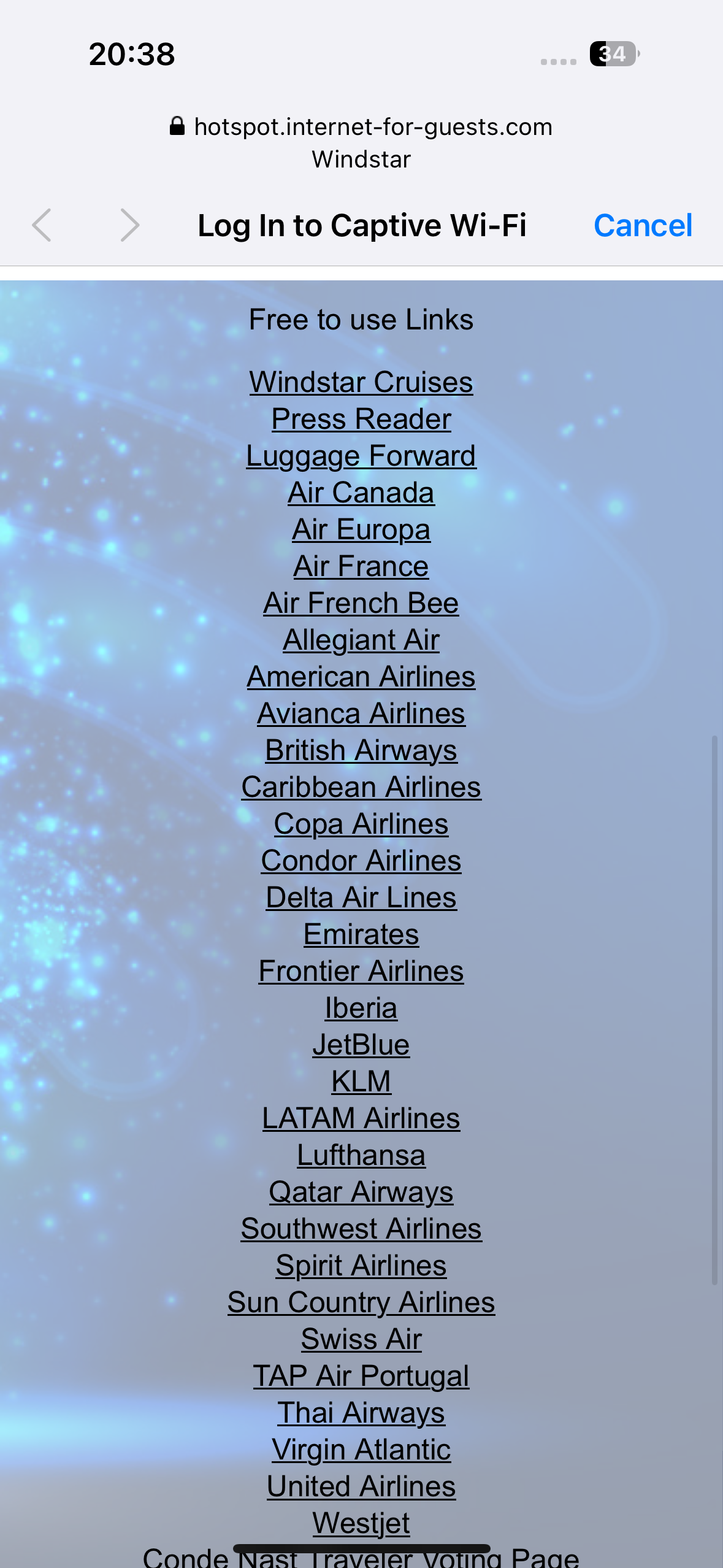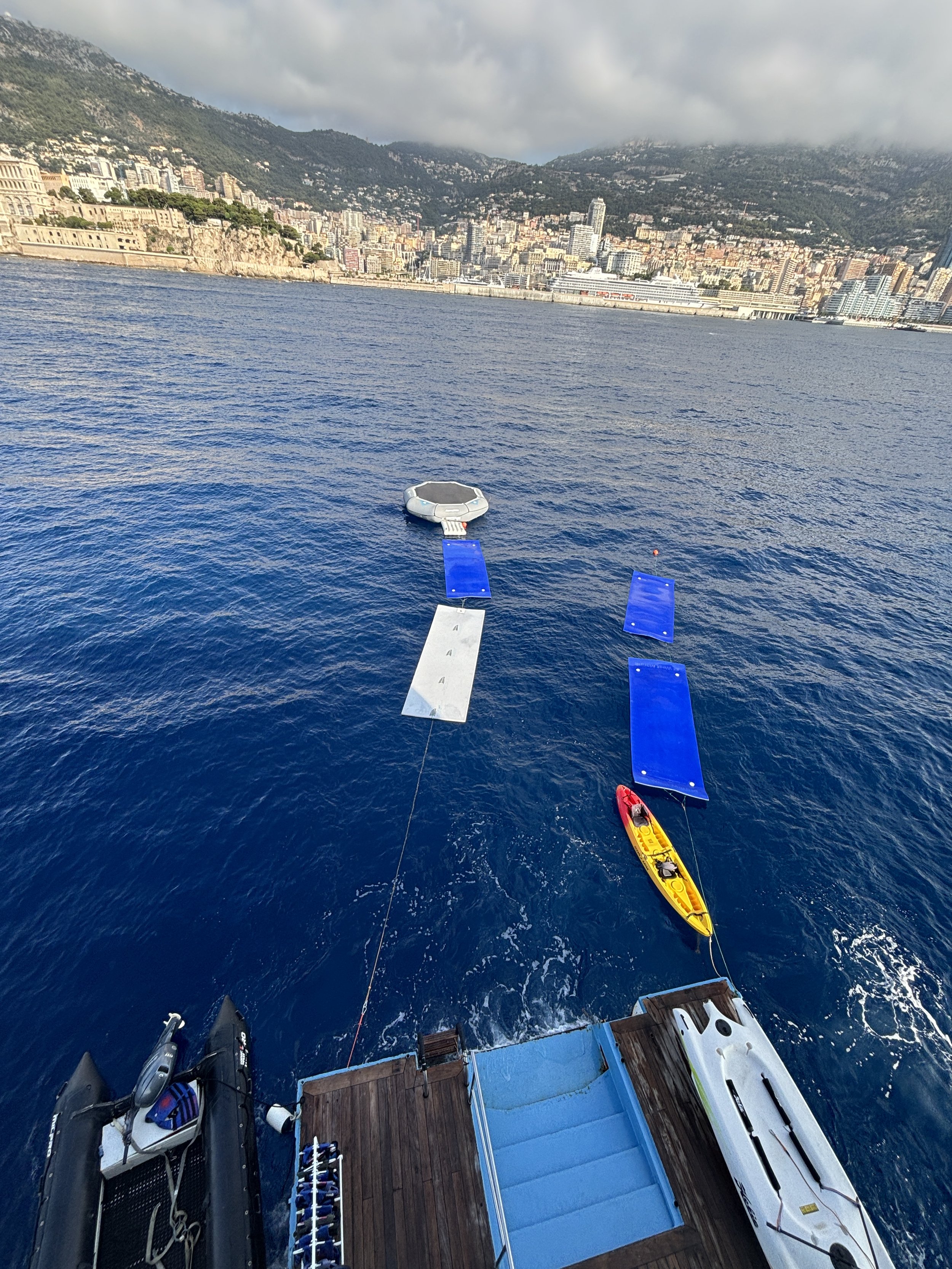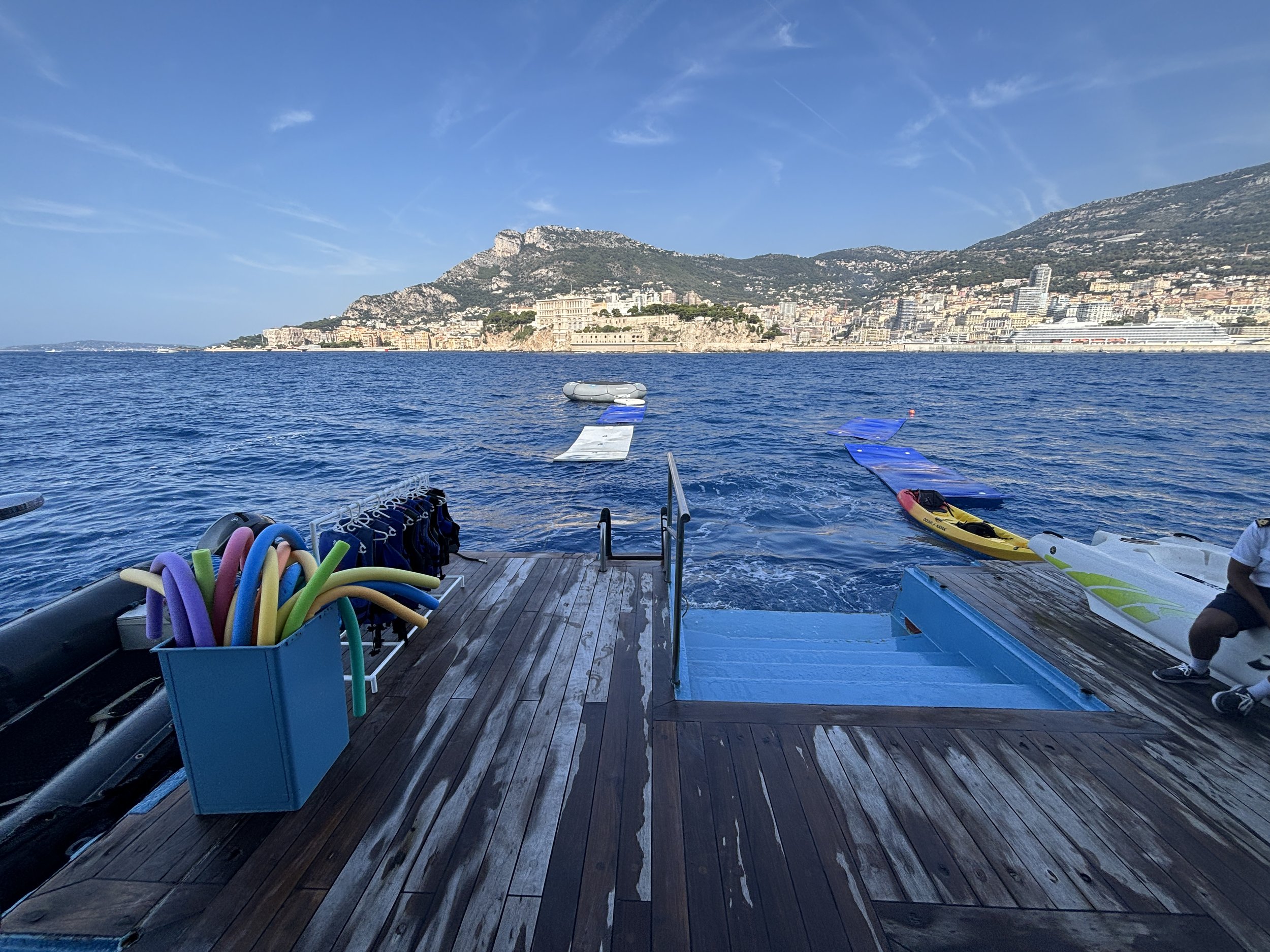Sanary-sur-Mer, the Provencal town that invented scuba diving
When it comes to French Riviera, the cute seaside provençal town of Sanary-sur-Mer may not feature as high up in the popular imagination as Cannes, Antibes or Saint-Tropez. This makes it, actually, a perfect fit for this site and its overarching team of showcasing underreported and charming places. Because, if there is something that is not in short supply at Sanary-sur-Mer is charm.
The charms of Sanary-sur-Mer were, in fact, well recognized by quite a few literary and artistic figures in the pre-war years. Aldous Huxley wrote “Brave New World” while staying in Sanary, for example. The list of notable creative people that also visited or lived in Sanary-sur-Mer at some point in that era includes English writer D. H. Lawrence and French film-maker Jean Cocteau, as well as a whole ensemble of German and Austrian intellectuals, Bertold Brecht, Thomas Mann and Stegan Zweig among them, who moved to Sanary in the 1930s, fleeing totalitarianism in their home country.
The colourful and lively fishing port of Sanary-sur-Mer main claim to world fame, however, is the due to the work of another of its illustrious residents, Jacques Cousteau, for it was here that the French oceanographer and film-maker, together with partners Frédéric Dumas and Philippe Tailliez, developed and tested the first aqua-lung. The autonomous subaquatic breathing technology which made scuba diving possible was at least partly developed and first tested in Sanary-sur-Mer.
We’ll get back to this latter point shortly, because one of the highlights of the town is actually its scuba-diving museum, but, first, a bit of context about Sanary!
Arriving to Sanary-sur-Mer from the sea
Let me start by saying that my impressions of Sanary-sur-Mer are shaped by the fact that I arrived to the town by boat.
This, I think, makes quite a difference, because Sanary-sur-Mer is truly a sea-facing town and its most iconic sights are never too far from the water!
Sanary-sur-Mer was one of the last stops in our Windstar cruise between Civitavecchia (near Rome) and Barcelona and which took us to other beautiful and iconic, yet somehow underrated, places such as the island of Elba.
Windstar’s “Wind Surf” as seen from the Tower of Sanary-sur-Mer
The port of Sanary is actually too small for even a relatively small ship, like our beautiful sail-powered “Wind Surf” to get in, so the transfer to and from the shore is done through the small auxiliary boats onboard (which have a double function as emergency rafts), a much more stylish way to get ashore!
Top things to do and to see in Sanary-sur-Mer
And this is, essentially, the sight that welcomes you as you sail into Sanary-sur-Mer: a colourful array of traditional fishing boats moored along the quais. Picturesque? Sure! And that’s the reason we are here.
We had just a morning in port, so our activity consisted basically in exploring the area near the quais, which is where most of the interesting stuff appears to be located. In the picture below you can get an idea of what we are talking about.
The outdoor produce market is at the far end (more on this soon) and the scuba-diving museum is just at the back of the tower from where this picture was taken. In between is the main seaside promenade with most commercial activity taking place around it.
Our first pit stop was the aforementioned outdoor market, which was fully stocked with all sort of appetizing stuff, from seafood to fresh produce and, of course, French cheese and charcuterie.
To be fair, these types of market are common throughout the Mediterranean. This doesn’t make them any less interesting, though! And in Sanary it really, really adds to the generally colourful setting.
From the market to the next highlight, the 14th Century “Tour of Sanary” it takes just a short pleasant stroll along the quais, where most of the town’s activity seems to take place anyway.
The town appears to be very well kept and it is also dotted with quite a few interesting decor elements, like a couple of statues in classical style representing the maritime and agrarian activities that have shaped the economy of this part of Provence for centuries.
There are also a number of shops, restaurants and cafés along the quais and in the adjacent streets.
These offer the chance to buy some rather tasteful, stylish souvenirs (not the banal sort that has become commonplace in many major cities) as well as wine and produce from the adjacent hinterland (a note for wine experts here: Sanary-sur-Mer is in within the Bandol AOC (Appellation d'Origine Contrôlée) wine region.
The two museums to visit in Sanary-sur-Mer
And that’s how we get to what I think is the towns most singular structure: the 14th Century Tower of Sanary (“Tour de Sanary”).
The town, actually, pre-dates the village. It’s common to find watchtowers and fortifications all along the Mediterrnean, which in old times used to be swarming with pirates of all sorts.
So, in the 16th Century, a fishing village sprung here, under the protection of the tower. It was originally called “Sant Nazari” in the local Occitan language, a name that over time mutated to the French “Sanary” (with the more modern “-sur-Mer” added later to highlight its seaside location).
The tower offers two things.
The first is the great views of the town and the quais from its rooftop. Much recommended, even if you have to climb a really narrow staircase!
The other is the museum of marine archaeology (marine archaeology is starting to become a regular theme of this site!).
The museum is actually spread over the different floors of the tower and it showcases some of the items of historical significance which have been found in nearby waters. Bear in mind that Sanary is located roughly halfway between two major historical ports, Marseilles and Toulon, and the sea lanes around town have been heavily plied since Ancient times.
The marine archaeology museum is, actually, a perfect complement to the other museum in town: the scuba diving museum.
Visting the Frédéric Dumas Scuba-diving Museum in Sanary-Sur-Mer
I have mentioned earlier that Sanary-sur-Mer played an important role in the development of the scuba diving technology.
French oceanographer and film-maker Jacques Cousteau, who happened to have a house in Sanary, is the most well-known name associated with this invention, but Cousteau’s partners Frédéric Dumas and Philippe Tailliez were also instrumental in this achievement.
The three were apparently known as “the Mousquemers” a French language game of words that alludes to in a not-too-veiled reference to Les Trois Mousquetaires (“The Three Musketeers”) the famous literary work by another Dumas, Alexandre, in this case.
Sanary’s scuba-diving museum is actually named after Frédéric Dumas and it shows the evolution of diving and subaquatic activities since the early days of diving all the way to the invention of the modern aqua-lung in the 1940s.
The museum is quite small. It is privately run and consists of a single ground-floor room in one of the buildings adjacent to the port.
It does have some interesting historical artifacts, including some very ancient-looking examples of diving suits as well as the first early models of autonomous scuba-diving equipment.
Definitely go visit if you are in Sanary, even if you are not into scuba-diving.
Before closing this post, it is necessary to mention that the other major attraction at Sanary-sur-Mer is, in fact, not in town, but in the nearby coastline. Despite the area being quite urbanized, there are still quite a few nice beaches and coves around!
And, it is like this, with this last view of the town’s sea front from the Windstar “Wind Surf” portholes, that this post about beautiful Sanary-sur-Mer comes to and end.
But the series about our Windstar Cruises adventures will continue soon with more interesting places!
48 hours in La Rochelle, Île de Ré and Rochefort: what to do and what to see
The history and fortunes of the French historical port of La Rochelle and its adjacent island, l’Île de Ré, are intrinsically tied to the Atlantic Ocean. In fact, the whole Charente Maritime region, where both are located, has always leaned on the sea as a source of wealth and activity. This extends, as well, to the nearby, also historical town, of Rochefort, which, while laying quite a few miles inland on the river Charente, was for centuries a major French navy base.
What follows is an account of my brief, two-day visit to this region and the places that I visited. By no means do I claim it to be the most exhaustive and comprehensive guide you can find on this region, but it presents a few ideas about interesting places you can visit if you have a car (important!) and a rather time-constrained schedule, as it was my case.
One particular aspect which you will find, perhaps missing to a large degree is gastronomy, since I prioritized sightseeing (and being on the move) to sitting down to have a proper meal. But I must say, that, having seen what I saw, I wouldn’t mind going back some day, with more time (and a larger budget!) to tick this box too!
So, here’s my short chronicle of my trip to La Rochelle, Île de Ré and Rochefort…
A walk through La Rochelle: the Vieux Port and the Old Town
La Rochelle has a truly majestic old port, with two stone towers giving access to its historical basin. This is, after all, a city which has played a key role in many episodes of the history of France. Since La Rochelle was a protestant bastion it played an important role in the French wars of religion in the 16th C. and it was, later on, besieged by royal forces led by the famous Cardinal Richelieu when he was combatting the Huguenot revolts in France in the 17th C.
It was also from La Rochelle through which most trade and immigration towards “New France” (Nouvelle France), that is, present day Québec, was conducted. So, the city’s trade networks extended across the Atlantic and onwards to many other ports throughout Europe.
Last but not least, La Rochelle was also a major German submarine (U-Boat) base during WW2 and there are some remarkable sites linked to that period.
Unfortunately, the impressive U-Boat bunkers at La Pallice (which were so solid that it was not possible to demolish them after the war) are off visits, since they are within the industrial port complex, although in summer it is possible to get close from the seaside if you book one of the organized boat tours of the port.
So, visitors interested in that episode of WW2 history that took place in La Rochelle have to make do with a visit to the, somehow misleadingly named “U-Boat Bunker”. It is advertised this way, and while it is true that it is a bunker and that it is linked to the U-Boat activities in the city, it is, actually, a much smaller facility which was built downtown to protect the valuable submarine commanders during air raids. I am sure it is also quite interesting to visit, but, unfortunately, at the time of my visit it was closed, so this is one of the things I will have to leave for my next time in the city. If you wish to learn more about it, though, you can have a look at it here.
My hotel (more on this further below) was quite close to the main train station and the historical center, so I went for a walk along the historical quays and the old town, which was quite nice, since it was a sunny, although quite cold, afternoon.
Went for a night walk, as well…
Overall, La Rochelle is a very tidy and clean city and the area next to the quays was truly lively and packed with people walking around and also sitting at the numerous cafés and restaurants.
The area on the far side of the basin from the old town is also not devoid of charms, there is an large aquarium and a maritime museum (which, like in the case of the bunker, could not visit do to timing) and a few interesting historical ships docked alongside.
One of them is the “Shtandard” a replica of a 18th C. Russian sailing ship which goes on tour regularly and that I had actually visited when it docked in Barcelona some years earlier!
I also found quite interesting a small area by the quays with small colourful houses, something which reminded me somehow of Scandinavia.
Where to stay in La Rochelle
B&B La Rochelle Centre Hotel
140 Bd Joffre, 17000 La Rochelle
https://www.hotel-bb.com/es/hotel/la-rochelle-centre
I opted for some place that offer good value, with some parking space and not far from the center, and the B&B Hotel ticked all the boxes (there are two B&Bs in La Rochelle, so make sure you check which one is yours! My navigator took me to the wrong one, which is not far away, a bit of oversight on my side!)
This is a functional hotel, do not expect luxury, but if you are looking for something modern, clean and efficient, I think the quality-price was pretty good. Staff were also very friendly.
It has a parking that costs €8 for 24h, although if there is quite a lot of parking space on the street it is located in, which is free to park in the evening from around 6pm to 9am and on Sundays, so depending on the times you need to park it may also be an option.
Where to eat in La Rochelle
Un Voyage à Damas
13 Quai de Marans, 17000 La Rochelle
As mentioned earlier, gastronomy is one of the aspects of my trip that were possibly sidelined in favour of having more time to see more sites and places. Nevertheless, I sat down for a quick dinner at a Syrian restaurant that I came across during my walk back to the hotel from the old town.
It was correct overall, you can see how they prepare the food. Service was good.
A day driving through the Île de Ré
The Île de Ré is an island located just off La Rochelle. In fact, it is not close to the mainland that it is linked by a suspension bridge (there is a toll which costs around €4 and is paid only on accessing the island, not on the way back).
So, I decided to go on a full tour of the island, all the way to its furthest point and using the northern road, which runs through the picturesque towns of La Flotte and Saint-Martin-de-Ré.
The Île de Ré seems to be an upmarket holiday destination in France, popular with French elites, a bit like the Hamptons is in the East Coast. And I can see why.
Île de Ré is a low-lying island where water is literally everywhere, not just on the ocean side, with long, open beaches, but it also has plenty of marshy areas where fine salt is harvested and oysters are grown. So, even if is not really a “wild” landscape, you always have the feeling of being close to nature. Also, the island’s few towns have, generally speaking, been remarkably well preserved and well kept and there is no shortage of interesting sites.
Pit stop at Rivedoux-Plage
Rivedoux-Place is the first village when you access the island and, while it doesn’t get mentioned in most of the online guides and other tourist information material I gathered about IÎle de Ré, I thought it was worth a mention here, since I found this place not devoid of charms.
As soon as you leave the bridge, the “island vibe” is evident, hard to describe in objective terms, but surely the feeling of being very close to the sea, which is obvious in Rivedoux, as the road soon starts tracing the contours of the coastline. At low tide present quite an interesting landscape, with the mainland bridge in the background and, even a few people venturing into the mud flats to pick up shells and other seafood.
Where to eat in Île de Ré (Rivedoux-Plage)
Perhaps my opinion of Rivedoux-Plage is also shaped by the fact that I enjoyed a great breakfast here:
Boulangerie Feuillette
126 Av. Gustave Perreau, 17940 Rivedoux-Plage
The choice of pastries and sandwiches at this place was simply mouth-watering and quality turned out to be great as well, as was the coffee and a very, very reasonable prices. Plus service was excellent (they even added a complimentary little pastry to my breakfast) and it offers a cozy environment with views to the sea. There is also some not crowded parking space next to it. I, actually, liked it so much that I stopped again in the evening in my way back.
Abbaye des Chateliers
It doesn’t take long after you leave behind Rivedoux-Plage for the many suprises that this island has in story to come into sight.
While I tried, unsuccessfully, to get a good view of the 17th C. Fort La Prée fortress (it was closed at the time of my visit), the ruins of the Abbaye des Chateliers, a 12th C. came into sight. These are located on an open field in a somewhat elevated plateau overlooking the sea.
There is a small parking space next door and some walking paths. The ruins are just the few walls standing, with some signs providing contextual information. In fact, the site is beautiful on its very own, particularly in a sunny, cold day, as it was the case, but the old derelict structure makes it rather special.
Visiting Saint Martin de Ré
The next stop was Saint-Martin-de-Ré, which is the largest town of the island, its “capital”.
The first thing that comes into sight are the imposing 17th C. ramparts, complete with a moat, and several buildings that, from the look of its, seem to still have a military function. Following the signs I got to a large outdoor parking which is on the east side of town, just outside the perimeter of the old town.
From here is a nice 2min walk to the old port following the seaside fortifications.
The center of Saint Martin de Ré didn’t disappoint! The area around the quays is perfectly well kept with the type of stone buildings and historical façades that are typical in this part of Atlantic France. I guess the sight hasn’t changed that much since the 18th C.
One interesting feature here is that the port is divided in two sections, one of them gets emptied of water in low tide, as it was the case at the time of my visit, with all boats being left literally in the mud. Another, inner part of the port, keeps its water thanks to a system to locks. This is, apparently a rather old system that has been place for centuries.
Saint-Martin-de-Ré was an important trading port in centuries past, exporting mostly salt from the island’s many marshes, as well as being the point of departure towards the penal colonies of many French prisoners, all the way until the first half of the 20th century.
The quay area is right now full of chic stores, selling fashion items and upmarket souvenirs (I really liked the nice vintage-style postcards on sale at several of the island’s shops) including a store dedicated exclusively to Tintin (the only one in France apparently!). The old town is dominated by the structure of the old medieval church (another derelict religious building!), most of which has been in ruins already from before the time of the French Revolution! (although a smaller church was built right next to it and it is active to this day).
Most of the interesting sights are along the quays, which make for an interesting walk.
There is also a tourist information center next to the parking lot, where you can get maps of the island and where I got perfect service when I went to ask for some itineraries.
Visiting Ars-en-Ré, one of France’s most beautiful villages
The next stop was Ars-en Ré, a small village located close to the island’s narrrowest point, on a narrrow strip of land with the sea on one side and a lagoon on the other one.
Ars-en-Ré is one of “Les Plus Beaux Villages de France”, a network which gathers close to 200 of the most beautiful villages in France. Members of this network must have some intrinsic aesthetic qualities and must also adhere to certain conditions and standards to remain small and cute.
There are, actually two such villages on the island of Ré, the other, La Flotte, I could only pass by very quickly, since by that time it was already getting quite late.
Ars-en-Ré has a small network of pedestrianised streets lined with whitewashed houses. But the main reference point is the triangular church steeple, in the center of the village. This structure, like it was the norm in Île de Ré in the past, is painted entirely white (the lower part) and black (the tip), because it had also a role as beacon, visible from far out at sea.
Where to eat in Île de Ré (Ars-en-Ré)
Le Fournil d'Ars-en-Ré
28 Pl. Carnot, 17590 Ars-en-Ré
Yes, another bakery!
But if you don’t want to spend much time sitting down, this place has a really nice assortment of sandwhiches and pastries and it is conveniently located on the village’s main square.
Btw, Ars-en-Ré has also a small port, which doesn’t open into the sea but onto the northern lagoon. At the time of my visit this area was undergoing some public works, so it was hard to access the lagoon from here and had to drive around all the way to a place called La Patache, which is on the northern side of the island, where the lagoon meets the open sea.
Phare des Baleines
This is a place I would definitely recommend visiting if you come to Île de Ré. The lighthouse is located at the westernmost point in the island, it’s all the way to the Newfoundland from here!
Besides being rather beautiful , a sort of textbook lighthouse in its shape. It is also the tallest structure in many miles around.
It is possible to go up, although beware, it requires climbing a spiral staircase with quite a large number of steps! (no lift available). The top of the lighthouse gives you a great 360º degree view of the islands and the surrounding ocean. So, it is well worth it if you can manage.
It was extremely windy when it went up!
At the base of the lighthouse there is a small exhibit explaining lighthouse technology and the history of lighthouse building in France. Pretty simple but quite interesting.
And, last but not least, despite its small size, the souvenir shop (which is also where you buy the tickets to go up the lighthouse, has also a rather amazing bookshop dedicated to naval and maritime topics!
Once you have visited the lighthouse, I recommend taking the small path that runs along the beach, which is called “Conche des Baleines”. This is a long, sandy beach open to the ocean which you can access by flights of stairs located every certain distance.
The beach was at low tide when I visited and it was possible to walk through the wet sand dotted with podles and seaweed. A number of long stone structures protrude from the beach into the ocean. These are "écluses à poissons", or “fish-locks” and have been used by the locals for many centuries to trap and capture fish when the tide recedes. These are an element of historical heritage and it is forbidden to walk on them or trample with them in any way. There used to be almost 150 of these all over the island, but only a small number are still currently in use.
If you walk another 500m towards the north you will come across another interesting historical site, this one not so ancient: two WW2-era German bunkers.
These were built as part of the “Atlantic Wall”, which the Germans built during WW2 to prevent allied landings (which finally took place in Normandy). The bunkers are currently half destroyed, since the sand dunes that they were built over have shifted with the years and parts of the structure have fallen over and been partly covered by sand, but it is still possible to inspect them from up close.
This beach has also an additional connection to WW2: it was here that the Omaha Beach scenes of the 1962 epic movie “The Longest Day” (possibly one of the best films about the way ever made) about the D-Day landings were filmed!
The coastal path all along the coast, following roughly the top of the dune ridge, quite a pleasant walk if you have the time!
Further north is another sizable village, Les-Portes-en-Ré, which I just skipped on my drive to La Patache, which is at the point where the island’s lagoon meets the ocean. Most of the island’s salt flats are located all around the lagoon, as are also some aquaculture establishments. However, there is not much to see, since the landscape is quite flat, with only the steeple of the church at Ars-en-Ré standing in the distance, on the far side of the lagoon, as the only recognizable landmark.
The return trip was following roughly the same route, with an stop also at several of the beaches along the way. The tide was now up, which made for an interesting change!
Visiting Rochefort
Since I had to drive to Bordeaux airport on my way back, there was a chance to explore some other sites of interest in the Charente Maritime region. So, I decided to make a stop at Rochefort, which is some 40km south of La Rochelle.
This town, located on the banks of the meandering Charente river, was between the 17th and early 20th centuries, a French Navy base and arsenal and its main sight is closely connected to this naval heritage.
La Corderie Royale
This very long and narrow building was, from the 17th C. and throughout the sail ship era, an industrial facility that produced all sorts of ropes for the French navy’s sailing ships (“corde” means rope in French, so “corderie” is the place where ropes are made).
The long ropes used on sail ships had to be extended to their whole length during parts of the manufacturing process, hence the 374 meters-long structure along the banks of the river Charente!
The place lost its importance after the navy switch to thermal forms of propulsion, which means that sails and ropes were no longer needed. The Corderie Royal was then abandoned and pretty much fell apart, until some local politicians had the idea to recover it for the city in the 1970s. It was then pretty much rebuilt to its former appearance and given a new use as a museum and cultural center.
Today part of the Corderie Royal is a museum explaning the past of this building, the rope-making process (with some rope-making artisans demonstrating the process on site) and the history of Rochefort as a French Navy town. Another part of the building hosts temporary exhibitions.
Stopping at La Galaxie des Pierres Levées
I stumbled upon this place literally by chance when doing a mid-way stop on the motorway between Bordeaux and La Rochelle.
In fact, prior to seeing it, I had never heard of this place, but found it unique enough to include it in this story.
La Galaxie des Pierres Levées is a massive conceptual art installation located next to the Pierre de Crazannes rest area (“Aire de la Pierre de Crazannes”) on the A837 motorway, not far from Rochefort, actually.
The sight is quite impressive (and a bit weird, tbh!) and it consists of a huge number of megaliths laid out in an open field.
The Galaxie des Pierres Levées (which would translate as “the galaxy of standing stones”) represents the five continents, represented by five megaliths at its center. From there, several arms stretch out in spiral, each with hundreds of sculpted megaliths. Apparently there are several artists, from different parts of the world, working on the stones each year. When completed it will have a total of 365 stones.
But this is not some strange archaeological site. It is in fact an installation, devised by an artist called Alain Tenenbaum. It started to take shape in 2005 and is expected to be completed by 2060. The site opened to visitors in 2023 (free entrance, just walk in) and new stones are being added on a yearly basis.
I wonder what archaeologists of the future will make of this!
Around the Mediterranean in style on Windstar Cruises Wind Surf
Cruise ships come in all shapes and sizes, but only a few of them are able to provide something akin to the super-yacht experience.
We are not just talking about a matter of scale (although this matters quite a lot too!) but of an entire philosophy that permeates every element of the experience. This is in addition to the truly unique wow factor that comes from sailing on one of only a handful of sail-powered cruise ships out there.
This is why, the moment the opportunity came up to sail the Mediterranean onboard Windstar Cruises Wind Surf, we didn’t think it twice!
What follows is our account of an unforgettable journey sailing through the incredibly blue waters of the Western Mediterranean, from Civitavecchia, near Rome, to Palamós, in the heart of the Catalan Costa Brava (you will find the itinerary on Windstar Cruises website as “Yachtman’s Harbors of the Rivieras”.
Keep reading for a detailed review of how the Windstar Cruises experience is like!
The journey was courtesy of Windstar Cruises. Opinions are all our own.
The Ship
The ship which took us on this Mediterranean journey, “Wind Surf” is one of only two ships of its kind ever built (the other being “Club Med 2”, which operates for the eponymous French tour-operator).
These two sibling ships happen to be also the two largest active sailing ships in the world (by length) and have quite some story behind…
Both ships were ordered by Windstar Cruises from a French shipyard in the late 1980s, but ownership changes at Windstar at the time put the project at risk. This is when Club Med stepped in. The French company took over the two ships and, upon completion, put them in service with the names “Club Med 1” and “Club Med 2”.
In 1998, Windstar Cruises was finally able to acquire one of the two, “Club Med 1”, and add it to its fleet after giving it its current name: “Wind Surf”.
At 14,700 tons and 617 ft (188m) of length, Wind Surf is small by the standards of a cruise industry that has got used to launching ever larger ships, but this is the whole point.
Wind Surf’s most eye-catching feature, the one that captures the attention (and the imagination!) of people onshore wherever it turns up is, of course, its superstructure, with five 67.5-meter-high masts and the accompanying rigging.
To be clear, Wind Surf is a hybrid, which is is mostly propelled by diesel engines. Wind, however, plays a key role, not just when it comes to helping propel the ship, but also in confering it a rather unique personality.
When making full use of wind power, Wind Surf propulsion is assisted by 7 triangular sails. These are rolled out through a full automated mechanism every day as the ships gets underway.
Wind Surf can carry up to 342 passengers and a crew of around 210. A passenger to crew ratio which gives you an idea of the type of personalized service Windstar Cruises strives to provide.
The ship has a total of six decks. There are 150 staterooms on decks 2 and 3 and 18 ocean view suites on deck 5. Those looking for an even more exclusive experience have a choice of 2 deluxe ocean view bridge suites and…wait for it…an “Officer’s Suite” which is located within the officer's quarters!
Most of the ship’s common areas are on Deck 4.
Here you find the reception, which is on duty 24/7, the excursions counter, a shop, a library, some workspaces, and a large lounge area (where some of the live entertainment and the pre-excursion briefings take place) with its own indoors café, as well as one of the ships’ restaurants, “Amphora” (more on food and drink onboard shortly!)
Before we proceed further, a note here about the elegant but unpretentious, no-nonsense decor style found throughout the ship, which we quite liked. It definitely adds to the authenticity of the overall experience.
The dominant pastel and wood-like tones inside and white-washed outside, both with touches of deep blue, do also a great job in setting the maritime yacht-like atmosphere.
On a schooner-like ship like Wind Surf, a big part of the action happens outside, whether it’s at the poolside terrace and bar, eating outdoors at the Veranda restaurant or simply sunbathing or walking along the decks while contemplating the Mediterranean coastline.
In this regard, one of the ship’s focal points is astern: the poolside area.
Wind Surf has a small pool, which, while not large enough to swim in it, is ideal to relax as you float and let the motion of the ship swing you around. There are two other adjacent warm-water hydro-massage tubs which provide great views of the landscape around.
Sun beds and a bar, which will prepare pretty much whichever cocktail you fancy on the spot, complete this particularly popular section of the ship.
Those of you that like to enjoy the sea breeze will be happy to know that there are two other partly open decks, 5 & 6, that allow you to walk the whole length of the ship, a full 360 degrees.
Deck 5 is, astern, quite similar in structure to the pool deck and located right above it, but instead of the pools, it has a larger bar with some indoor space that becomes the ship’s focal point late in the evening, when it usually hosts live music shows.
Also on Deck 5, but indoors and amidship, you find the Spa (more of this later) and, closer to the ship’s bow, the bridge. In this regard, We were positively surprised by the friendliness of the captain and crew, who showed us around when we happened to walk by.
By the way, in case you were wondering this is what the bridge of Wind Surf looks like!
Keep going up and you get to Deck 6 (the top one). Here you can get really, really close to the rigging and it is the best spot from where to watch the unfurling of the sails. This takes place every evening to the sound of some really epic music by Greek composer Vangelis.
It is pretty amazing to watch how, thanks to the automated mechanism, it takes only a few minutes for all seven sails to be rolled out.
It is also on this deck, on the bow side, that you find Wind Surf’s other restaurants: Veranda/Candles (partly outdoors) and Stella (which is fully indoors).
This deck, particularly the platform right above the ship’s bow, is a great place to enjoy the actual sailing sensation.
The state rooms
As mentioned earlier, there are different types of cabins, the vast majority of them are state rooms and all of our comments refer to this type of accommodation.
Our state room was on Deck 3, but I think they are all pretty similar regardless of the deck you are in.
You can move up and down the different decks either through the stairs or by using the lift. We used the former option most of the time, since distances within the ship are always short and it can be much faster to just walk than wait for the lift.
So, without further ado, let’s get into the room to see how they look like…
State rooms are 188 sq ft (17.46 sq m) and are fitted with a queen size bed and an ensuite bathroom.
I was very positively impressed by a number of tiny details in the room.
Let’s start by the Queen Size bed, which, we can attest, is truly comfortable. It’s got good natural light, but also lamps and a couple of reading lights. There’s a flat screen TV with a DVD player as well (tbh, we didn’t use it at all, since we seldom watch TV, but some may find it useful to know that it’s there).
But, do you what’s the one thing that we really, really liked? The two round portholes!
Yes, I am aware that nowadays most cruise ships have balconies, and these are cool, but…portholes? That give you the feeling to be sleeping onboard a real ship! And, you know what? If you like balconies, I’ve got news for you…pretty much the whole three upper-most decks of Wind Surf are, in essence, a large interconnected balcony, with plenty of space to sit down, lay down or sunbathe.
More stuff: there is plenty of space for storage, there’s a whole cupboard and a large amount of drawers and shelves, so we never felt the space was tight.
There is also a desk, which comes in very handy to shift through the trip’s papers and is also stocked with some fresh fruit.
Then some of the usual amenities: a safe, a mini-bar, hair-dryer, etc. There are also robes available.
Another pleasant suprise is that there are also universal electricity plugs (since Windstar Cruises is an American company and most passengers are from the US, I had brought a US-EU adapter, but it turned out not to be necessary!).
The bathroom is about as big as it can be in this kind of setting, but pretty well fitted.
It’s got a spacious sink top. It must have a really efficient air circulation mechanism because things, like wet swimming suits, dry really fast, despite the confined space.
Also, the shower is really nice, powerful! (perfect to rinse the salt out and freshen up after a water sports session at the marina).
There is also a set of L’Occitane toiletries.
The restaurants
One aspect of the Wind Surf experience we particularly enjoyed was food and drink.
Let’s start by saying that all meals are included in any of the four restaurants onboard, which is great. Also, regardless of each of the restaurants offering a somehow different type of experience (some elements, like the wine list were common to all, though), the food was really great in all of them.
There are four (in fact, three, if you count Veranda and Candles as one) restaurants onboard Wind Surf:
Veranda, which is on the top deck, partly outdoors, and is the only place open for buffet breakfast and lunch
Candles, which is, basically, Veranda but turned into an à-la-carte, reservation-required restaurant in the evenings
Amphora, which is the largest of the ship’s restaurants and located on the main deck
Stella Bistro, on the top deck indoors, specializes in French cuisine and it is, possibly, the poshest of the lot.
One important thing to bear in mind, though, is that while Veranda and Amphora work on a first-come-first-served basis, Stella Bistro and Candles, require advance reservation and our advice is to book early in the trip because they fill in really fast!
And, btw, Windstar Cruises has a partnership with the James Beard Foundation, a non-profit organization based in the US which aims to elevate the culinary arts. Some of the dishes onboard have the James Beard Foundation stamp.
Shortly below we will proceed to offer a glimpse of each of them.
Next a word about the ships’ bars. There are three of them, two astern, on decks 4 (poolside) and 5, and one indoors at the ship’s Lounge.
It’s important to note that, while all meals and non-alcoholic drinks are included for all passengers, it is not the case for wine and other alcohol drinks (and this includes the meals you have at restaurants).
If you are on an all-inclusive package, you get all drinks, no matter which one, by-the-glass. Otherwise you need to purchase your drinks individually or buy one of the day packages.
Whether you drink or not, is your decision, now, if you do, it may be a good idea to make sure your package includes drinks, since Wind Surf is stocked with a good wine cellar (at this point, special mention gotes to head sommelier Eleonora, which provided great recommendations throughout the trip!) and their staff can really prepare nice cocktails!
So, as promised, let’s go have a look at each of the restaurants. During our trip we had a chance to try all of them at least once and here is a summary of our experience.
Please note that the menu may vary with time and route!
Veranda
This is the most casual of the lot. As the name implies, it is located (partly) outdoors, on the top deck, although it does have space indoors too.
This is the only place to have breakfast and lunch, mostly from a buffet with both cold and warm dishes, although you can order some things à-la-carte too.
The buffet offers pretty much the same basic choices daily, although with some variations. The à-la-carte offering varies a bit every day, particularly when it comes to items such as fish.
Some of the food is prepared outside, where there is an open grill.
We would say the main thing with Veranda is choosing the right table for the time of the day in order not to get too much direct sun, since not all tables have cover. If in the Mediterranean in the middle of the summer it can get really hot already quite early in the morning!
Below are some snapshots of our meals at Veranda, to give you an idea.
Candles
Location-wise, Candles is the same as Veranda, but in the evening it becomes an à-la-carte restaurant and advance reservation is required.
We particularly enjoyed the fish dishes here!
Amphora
This is the everyday restaurant for dinner when onboard. You don’t need an advance reservation, you just show up and wait to be seated (which, at least in our case, was always immediately, since the place is rather big!), which makes it often the “default” option for dinner.
However, don’t let this casual approach mislead you, Amphora is a proper sit-down restaurant offering a pretty good quality experience, both in terms of food, service and atmosphere.
If anything, it gets, perhaps, a bit less of natural light than the other venues, mostly due to the fact that is located one deck down.
We had dinner a few times at Amphora, so here is a collection of images of what we had.
Amphora Meal 1:
Tomato Tart
Seared U10 Scallops
Vitello Tonato
Pan-roasted sea bream
Amphora Meal 2:
Slow-braised octopus
Spanakopita
Duck leg confit
We particularly liked this Californian Cabernet Sauvignon (thanks for the recommendation to sommelier Eleonora!)
Amphora Meal 3:
Stella
This is possibly the most “upmarket” of all of Wind Surf’s restaurants.
French Parisian Bistro
It requires reservation and we advise it you do it early in the trip. We left it for our second day and it was actually quite hard to find a spot, although staff made a good effort to finally accommodate us!
It is located on the top deck, right next to Veranda/Candles, but inside and closer to the ship’s bow.
Really nice layout and a bit more airy and with more natural light than Amphora.
The food was also excellent. Which one we like the most? It’s hard to say and I’d say it comes down to the specific dishes. The wine list was the same for both restaurants and here I must add a special mention to the Wind Surf’s sommelier in chief, Eleonora, which was a nice and very insightful guide in our choice of wines throughout the whole week (she shuttles between the different restaurants).
Amenities
So what else can you expect onboard a Windstar cruise. In this section we have tried to summarize several other aspects of the experience.
The fact is that, even on such a relatively small ship, there is so much to do that ultimately you have to be selective. What we describe here is what we did and it is just a cross-section of what is available.
Onboard Wifi
Wind Surf is equipped with SpaceX Starlink satellite connectivity, which provides fast and reliable internet everywhere, also when on the high seas.
Take into account, though, that, just as with the drinks allowance, access to Starlink depends on the package you are on. In any case, it can be purchased separately.
The onboard Starlink pass gives access to one device at a time, although it can be switched between devices depending on what you need the connectivity for.
Bear in mind that, if you have an EU mobile phone with a data plan, you may get internet access while on port and close to shore (thanks to the EU’s roaming directive), but as soon as the ship sets sail, you will need to log into the ship’s satellite network to get reliable connectivity.
Whether you have Starlink access or not, all passengers have access to a number of websites (these includes the Windstar Cruises as well as many major airlines and other travel-related resources. It also gives access to a digital media kiosk which gives access to several major media outlets.
Spa & Fitness
Wind Surf has also its own onboard spa, which offers a broad selection of treatment. These must be booked in advance and are paid separately.
In my case, I opted to undergo a postural and walking assessment, conducted by one of the onboard spa specialists. This included a postural evaluation, an analysis of the feet position when walking and a 40-minute session to practice some exercises for postural health.
While technically booked at the spa, this was done at the onboard gym.
This gym is relatively small (the right size for the ship, since it was never crowded), but well equipped with fitness machines, weights and other equipment. It also has lots of natural light, since it is located on the top deck.
Shows, music and entertainment
Shows and other social functions take place pretty much daily during the trip, usually in the evenings.
Dont’t expect, however, the sort of large theater-like spectacles you find on large cruise ships. On Windstar everything is much more intimate.
This is the case of the live music performance that takes place every night at the Deck 4 bar, for example.
We also enjoyed a Pub Quiz evening, brilliantly conducted by PJ, a South African crew member that acts as the ship’s master of ceremonies.
Other occasions that provided an opportunity to meet personally the crew and other fellow passengers were an evening drink with the captain, a thematic evening dedicated to learning about Polynesia (a part of the world where Windstar Cruises has quite a lot of activity) and a star-gazing meeting at the bridge at night, with the guidance of Wind Surf’s captain and other officers.
There was also a show evening at the Lounge in which several members of the crew performed several dances from their countries of origin as well as some humoristic sketches, everything conducted again by the very talented PJ!
This account wouldn’t be complete without a mention to two other special, and rather tasty!, treats that we got to enjoy in the perfect weather of the Cote d’Azur:
One was the ice-cream evening by the pool - no further ado needed.
The second, and on a much, much larger scale, was the outdoor dinner-barbequeue that all passengers were invited to join while the ship was anchored of Cannes.
Massive amounts of super-fresh food was cooked and served on deck in a casual, festive atmosphere. The evening was also amenized by live music. Below is a collection of pictures from that evening to give you an idea of the scale of it all.
And if we are talking about the “soft” aspects of the experience, we would also like to highlight the level of attention and service from the ship’s crew, particularly from the crew member assigned to take care of our state room (thanks Raysid!), which kept leaving small nice details for us to find when coming back from shore! Here’s a small sample :)
Excursions
An integral part of every cruise experience are, of course, the shore excursions and Windstar is no exception!
In this regard, the relatively small size of Wind Surf becomes a big plus, because it allows it to call at the smaller ports no other cruises are able to enter or, simply, dock offshore and offer a combination of excursions and water sports (both are feasible if you time your shore visits well!).
At every stop, usually 4-5 shore excursions are offered, with different intensity and duration (from 2 to 8 hours). Unless you are on an all-inclusive package excursions are contracted separately, with prices ranging from some $60 for things like a walking tour of Cannes to something like $250-300 for longer outings, which in some cases included wine tastings and other activities.
It is recommended to book in advance because spots are limited and the most popular excursions fill up fast. Assembly is usually at around 8-8.30am.
Those going on shore excursions have access to quite a lot of prep info, starting with a briefing the day before at the ship’s lounge, which provides not just practical tips, but also some cultural and historical context about each destination. You also get a one pager delivered to your room (these resources can also be accessed digitally on the ship’s portal)
When Wind Surf anchors off-shore, such as at Portofino, Montecarlo, Cannes and Sanary-sur-Mer, the ship’s auxiliary launches are used to shuttle passengers to and from shore (there is always a small Windstar branded tent onshore by the embarkation/disembarkation point).
This, in my opinion, gives to this type of smaller cruises and extra allure!
We went to shore at all the ports or towns that Wind Surf stoped at, although we only took one organized excursion, during our Cannes stop to the nearby town of Antibes.
A group of some 20-30 of us left Cannes in a bus together with a local guide, who showed us around the old town of Antibes (which has Ancient Greek origins and is one of the oldest cities in Southern France).
Our program was roughly as follows:
8.15am Assembly and transfer by launch to the port of Cannes
9am Bus to Antibes (which is some 15 miles distant)
9.30 to 12.30 Guided tour of Old Antibes, a relatively small but charming little seaside town, complete with a castle and a lively fresh food market. The tour included also an a taste of absinthe at a local historical bar.
13.00 Back onboard
Our Itinerary: Civitavecchia (Rome) to Palamós
While the purpose of this post is to describe the experience onboard Wind Surf, the itinerary and choice of ports is, of course, is also an essential element of the journey.
Sailing in the Mediterranean is synonymous with landscape and history overload, so we provide here just an outline of each, and have decided to describe each of them in a series of separate posts.
Portoferraio, Elba
A beautiful little island, the largest of the Tuscan archipelago, and renowned for being the first place of exile of Napoleon Bonaparte. While it is certainly a must for Napoleonic-era buffs, there is a lot more than Bonaparte on Elba, including a picturesque steep old town and some amazing beaches.
Portofino (and Cinque Terre)
A postcard-perfect colourful seaside hamlet which encapsulates the essence of the “poshest” Italian Riviera. It is also a stepping stone to explore other beautiful spots along the Ligurian coast, even the somehow distant, but still pretty accessible by public transport, Cinque Terre.
Montecarlo
A European classic, the world’s second smallest country and a billionaire’s lair. Getting into Montecarlo from the sea is quite the experience!
Cannes (Antibes)
Cannes is famous because of its connection to the world of cinema and, while we gave the modern city a pass, it is also a hub to explore other locations along the Côte d’Azur (as we did visiting nearby Antibes).
Sanary-sur-Mer
This was quite a discovery! I must confess I hadn’t heard of this small, colourful seaside town before, but it fit the program perfectly. Just the right size for a mid-morning visit, stroll along the pleasant quais, climb the town’s old tower and do some shopping around.
Palamós
The largest port in the Catalan Costa Brava. While the town of Palamós is nothing to write home about (it was aesthetically destroyed by 1970s architecture). It is a hub to visit some beautiful spots in the area, such as the medieval villages of Pals and Peratallada or some of the nearby coves and beaches. We actually ended our cruise here, since we had planned to stay a few more days in the Costa Brava area and it made more sense logistically to skip the last night of the cruise.
Barcelona
Not much to add here! One of Europe’s great cities and one we are not neutral about, since we call it home!
Each of these places has a charm of its own, but we would say that what remains constant is the awe that the presence of Wind Surf generated among those watching it from afar!
Water sports at the Wind Surf marina
We have left for the last what is, in our opinion, one of the highlights of a Mediterranean cruise on Wind Surf: the marina.
When the ship is at anchor, weather permitting, the area astern of deck 2 becomes a water sports platform from 10am to 12pm and from 1pm to around 4-5pm.
Forget about material things. This is what true luxury is about!
Whether you are into active water sports, such as kayaking or paddle surf, or you just wish to chill out on an inflatable platform within sight of iconic landmarks like the Montecarlo skyline, the Wind Surf marina has you sorted! Just show up an enjoy. Towels and equipment are provided.
There are, of course, some limitations, such as, not venturing further than some 100m from the ship, but overall, it is pure bliss!
So, in summary, what’s our overall impression of Windstar’s Wind Surf cruise?
We’ve got some experience with cruises, including some high end ones on relatively small ships, and Windstar’s is certainly unlike any other cruise we’ve been on.
It is not about the, let’s say, “classic”, more material, idea of luxury, although on this account Windstar also scores high (particularly on the culinary front!), but about being able to do things that are accessible if on a small ship: water sports at some of the most exclusive spots on the Cote d’Azur, accessing small ports, star-gazing in the company of an experienced sea captain and so on…
Also, the uniqueness of Wind Surf. Granted, sails only provide part of the propulsion, but, still, it is nice to sail on such a majestic ship. There is something special about watching the coast fade in the distance from the wooden deck as the sail unfurl: the feeling of connection to the sea and to thousands of years of maritime history.

